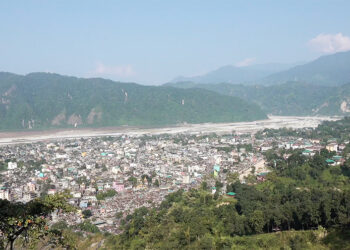 Chilli powder, a staple spice in Bhutanese kitchens, may contain harmful levels of lead. To verify this, over 120 chilli powder samples from Paro’s Dogar Gewog were tested today as part of the 13th International Lead Poisoning Prevention Week. Among the 20 districts, Paro and Haa recorded the highest blood lead level in children. These districts are also the main producers of the spice in the country. The first National Blood Lead Level Survey also found traces of lead in chilli powder, including other spices.
Chilli powder, a staple spice in Bhutanese kitchens, may contain harmful levels of lead. To verify this, over 120 chilli powder samples from Paro’s Dogar Gewog were tested today as part of the 13th International Lead Poisoning Prevention Week. Among the 20 districts, Paro and Haa recorded the highest blood lead level in children. These districts are also the main producers of the spice in the country. The first National Blood Lead Level Survey also found traces of lead in chilli powder, including other spices.
 In these two districts, the landscape is often dotted with red roofs, not from paint, but from chillies drying in the sun before being ground into local chilli powder.
In these two districts, the landscape is often dotted with red roofs, not from paint, but from chillies drying in the sun before being ground into local chilli powder.
 But could this traditional practice be contaminating chillies with lead? To find out, more than 120 residents from Dogar Gewog brought chilli powder from their homes for testing.
But could this traditional practice be contaminating chillies with lead? To find out, more than 120 residents from Dogar Gewog brought chilli powder from their homes for testing.
“One of the potential sources of lead was spices. About 20 per cent of the spices we found in the national survey had lead. So, one of the unique sources here is drying chillies on roofs, and we are not sure if there is lead in the chillies. And so we use this opportunity to test about 120 samples of chillies from everyone’s household to then find out if the way they are being dried, ground, or someplace along the way, if there is any lead being added or contaminated into the spices,” said Dr Phillip Erbele, Research Specialist, MECRIT, KGUMSB.
Alongside the testing, the department of public health with support from UNICEF also conducted awareness sessions on lead poisoning, its sources, and its health impacts.
“Until now, people were unaware of lead poisoning. Today’s advocacy helped a lot, and people asked good questions. Paro recorded 98.7 per cent of lead, and we tested some chilli samples from Dogar Gewog. While we await the results, this programme was very helpful and should be extended to other districts as well,” said Kinley Penjor, Dogar Gup, Paro.
“I had never heard about lead before because we don’t have a TV or radio. Today was my first time learning about it. The officials explained their health effects and told us not to dry chillies on rooftops, as they might contain lead,” said Nima Dema, Resident, Dogar Gewog, Paro.
“I had heard a little about lead poisoning on TV before, but it wasn’t clear. There was no research done in the past, and we had been consuming from potential sources, but after today’s programme, we understand how lead contamination happens, how to prevent it, and what its effects are,” said Changlo, Resident, Dogar Gewog, Paro.
After the initial testing, if higher-than-expected lead levels are detected in the chilli samples, confirmatory tests will follow.
Researchers will then examine where the chillies came from, how they were dried, and whether the grinding process contributed to lead contamination. The test result will be shared next week.
Devika Pradhan
Edited by Sonam Pem









